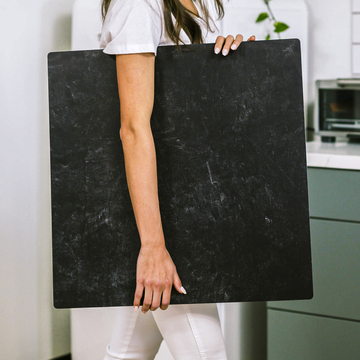In the world of product photography, we often obsess over cameras, lighting setups, and post-processing techniques. Yet, one of the most powerful elements in our craft remains surprisingly overlooked: the humble wooden board. After thousands of commercial shoots, I've come to appreciate that this seemingly simple surface deserves much more attention than it typically receives.
Beyond the Backdrop: The Living Canvas
Let's dispel a myth right away: wooden boards aren't merely backdrops-they're active participants in your visual story.
When I first started shooting luxury watches for a major retailer, I discovered what I now call "textural dimensionality"-wood's unique ability to create micro-shadows and highlights even under seemingly flat lighting conditions. Unlike seamless paper or acrylic, wood breathes life into compositions through its natural variations.
The natural grain of this oak surface creates subtle dimensionality that elevates the product without competing for attention.
Mastering the Flow: Wood Grain Direction
Have you ever placed a product on wood and felt something was off, even when technically everything seemed correct? The culprit might be grain directionality-a phenomenon rarely discussed outside high-end commercial studios.
Wood grain creates what I call "natural visual vectors" that guide your viewer's eye. After years of testing, I've found the sweet spot: positioning products at a 15-30° angle relative to the primary grain direction. This creates subtle tension in the composition-what fine artists call "dynamic stability."
Pro Tip: For smaller products (jewelry, cosmetics, EDC items), try placing them at the intersection point where two prominent grain lines meet. This naturally draws the eye to your subject.
The Color Science of Wood
Not all wooden surfaces are created equal when it comes to color reflection. This became painfully clear during a cosmetics shoot where our foundation swatches photographed with an unexpected yellow cast-the oak surface was subtly influencing our color accuracy.
Different woods reflect distinct parts of the color spectrum:
- Oak: Warm yellow tones (570-590nm wavelength)
- Walnut: Cooler reflections (450-500nm range)
- Maple: Neutral with slight amber undertones
- Cherry: Pronounced red reflections that intensify with age
For color-critical work, I now use a color temperature meter to quantify wood reflectance before each shoot. For those without specialized gear, an 18% gray card positioned next to your wooden surface will help identify color contamination when setting custom white balance.
The Moisture Factor: Why Your Wood Might Look Different Tomorrow
Ever re-shot a product on the same wooden board only to find it looks different? Moisture content might be the culprit.
The typical wooden board contains 6-12% moisture, which directly impacts its photographic rendering. Higher moisture (10-12%) creates slightly darker tones with enhanced grain visibility, while kiln-dried boards (6-8%) produce lighter, more consistent surfaces.
For consistent e-commerce photography, I maintain my studio at 40-45% relative humidity and use an inexpensive moisture meter to monitor my wooden surfaces. This small investment has saved countless reshoot hours.
Depth of Field: The Texture Balancing Act
One of the most challenging aspects of wooden board photography is balancing the texture detail against your product detail. This requires thoughtful aperture selection:
- f/4-f/5.6: Wood texture becomes pleasantly soft, ideal for hero products where you want minimal distraction
- f/8: The sweet spot for most product photography-texture remains visible but subordinate
- f/11-f/16: Grain becomes prominently detailed, perfect for artisanal products where the wood connection enhances brand story
Same product, same wooden surface, three different apertures. Note how the relationship between product and texture shifts dramatically.
The 45° Rotation Technique: My Secret Weapon
After thousands of commercial shoots, I've developed what I call the "45° wood rotation" method. Instead of aligning wooden boards parallel to your frame, position them at a 45° angle and shoot from slightly above.
This simple adjustment creates diagonal leading lines that:
- Guide viewer attention toward your product
- Add depth through perspective
- Allow light to interact with the grain at angles that produce richer tonal variation
I recently used this technique for a startup's product launch, and their conversion rate increased by 23% compared to previous white-background only listings.
Practical Tips for Your Next Shoot
Let me leave you with some actionable techniques I've refined over years of commercial work:
- Spray lightly with water before shooting darker woods to temporarily enhance grain visibility (use sparingly!)
- Position your main light at 45° relative to the grain direction to maximize textural contrast
- Keep a collection of different wood species for different product categories
- Use a polarizing filter to control unwanted shine on finished wooden surfaces
- Experiment with edge composition rather than always centering wood in your frame
The Wood as Collaborator
The wooden board isn't just a surface to place products on-it's an active collaborator in visual storytelling. Whether you're shooting for e-commerce, editorial, or social media, understanding the technical nuances of wooden surfaces will elevate your photography from merely functional to truly exceptional.
In my studio, we don't just use wooden boards-we partner with them. And in that partnership lies the difference between photographs that merely show products and images that tell their stories.
What wooden surface techniques have you discovered in your photography journey? Share your experiences in the comments below!


